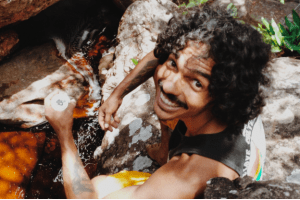When Sree Kancherla arrived in a remote village in India, she met an 83-year-old weaver. He had been making fabric for 70 cents a day since he was 12.
In the supply chain, he was a faceless worker whose fabric would pass through multiple hands before being sold as a t-shirt by H&M. That weaver was so far removed from the end product that his voice and story were completely lost.
It was then Kancherla realized: “I want to be a voice for the voiceless.”
Kancherla — the Global Director of Sustainability at Kearney, a top management consulting firm— has been interested in human rights ever since she was in high school. Starting her career working in law and policy for the UN, Kancherla eventually decided that she wanted to work face to face with the issues she was trying to solve: poverty and the lack of inclusivity in the workplace for women in developing countries.
While trying to plan that career transition, Kancherla read an article about social entrepreneurship — a business model that uses entrepreneurship to create positive social change — and she eventually found an organization not only specializing in this kind of social change but one that would allow her to get the hands-on experience she wanted.
Living in India and then Sub-Saharan Africa, she worked directly with the men and especially the women creating the clothing we wear. It was there she understood that “at the end of the day, everybody wants to be able to feed themselves and educate their children”
Utilizing her knack for networking, Kancherla got into consulting to bridge the gap between entrepreneurs and innovators and the corporations and governments looking for that innovation and improvement. She enjoyed the process of identifying problems and using her network and prior experience to solve them.
In one instance, she was working with a beer company. They sourced the majority of their wheat from Ethiopia and were concerned about labor issues happening on the farms.
“Oh, I have been to your wheat. I’ve been to your farm,” Kancerla told them. “I know exactly what’s happening.”
While Kancherla has worked in a variety of fields, she’s particularly interested in the fashion industry. “Where” she says, “we have a great influence on creating impact.”
From raw material to finished goods, there are multiple stages that materials go through to get to store shelves, each with their own set of potential human rights issues.
When I asked to give specifics, Kancherla asked me what I liked to wear.
I responded with “skirts”.
“So let’s say you’re buying a really cool skirt,” Kancherla said. “Who is the supplier that’s providing the buttons on it, or the zippers on it, or even the cloth for it?”
Kancherla explained that it’s not human rights abuses in the main factories that put together the products that are the biggest problem. The problem is where those factories source their materials from and, even further down the supply chain, in the procurement of raw materials.
When thinking of human rights abuses, you might imagine a sweatshop where laborers are overworked and underpaid. While modern slave labor and child labor are both major problems in the fashion industry, so too are women’s rights in the creation of materials.
The issues women face in developing countries are driven by a multitude of intersecting factors. Primarily though, women get little consideration in the workplace. When Kancherla was in India, she noted the lack of toilets in the farms. While the male workers could relieve themselves anywhere, the female workers could not, being miles away from the nearest restroom. There are also no unions, so there are no protections if they need to take a day off to take care of their children or because of a bad menstrual day.
To assess these conditions and make improvements in their supply chains, companies have begun to adopt a social responsibility framework called “ESG”—environmental, social, and governance. Each sector has its own metrics.
The framework of ESG is used by companies to hit certain “KPIs” — key performance indicators. These are thresholds that they have to achieve to follow industry standards.
Kancherla explains that while other firms specialize in gathering data and assessing whether companies are hitting their ESG goals, her job is to review their goals and advise them on how to get there. While we might think of sustainability as just environmental, Kancherla specializes in “big S” Sustainability, which is defined by the United Nations’ Sustainable Development Goals as including both environmental sustainability and social impact.
However, advising companies comes with challenges. When I asked if there are specific numerical goals companies are trying to hit, Kancherla explained it is different from assessing greenhouse gas emissions. For the fight for human rights, the hardest part is measuring progress.
“No one wants to admit to what they’re doing,” Kancherla told me. That makes numerical goals hard to establish. “It’s more qualitative and how you can change your policies and engage with the people within your supply chain.”
Given these challenges, I asked Kancherla if there was a particular project she was proud of. After thinking for a minute about it, Kancherla smiled.
“So a large part of what I focus on is human rights,” she says. “[If] we are able to build business models that give individuals that skill set that they need, that it’s what really empowers them, but also gives them the wages that they can control. This is really where true change happens.”
She went on to talk about a project in which she helped a company develop a model where the women workers were shareholders in the companies they were working for. These women collaborate directly with the company’s designers, get paid a fair wage, and can stay in their home villages.
“That kind of a model is what eliminates human rights [abuses] and [is] innovative.” Kancherla explained. This is because it involves the women as an active part of the organization, as well as refine their skills, and overall empowering them.
Throughout her work with companies and suppliers, Kancherla has also learned the importance of consumers’ voices in making a difference.
“I work with these companies every single day,” Kancherla said, “And the very first question they ask me is, well, does Gen Z care? Like, do the consumers care?”
She expressed the importances of transparency in the fashion industry. While companies love to greenwash, consumers don’t have to buy from them. There are websites like Good On You, which ranks fashion brands based on sustainability. Shopping second hand and thrifting are alternatives too.
“Choke them where it hurts,” she says. “which is the financials”
All of this is important because the end of the day, “We want to feel good about what we wear because of the style,” Kancherla notes, “but we also want to feel good [because of] what it means to other people that have been part of [the process] and the environment.”












